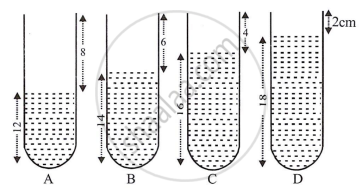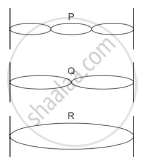Advertisements
Advertisements
प्रश्न
In following figure shows A, B , C and D represent test tube each of height 20 cm which are filled with water up to heights of 12 cm, 14 cm, 16cm and 18cm respectively. If a vibrating tuning fork is placed over the mouth if test tube D, a loud sound is heard.

- Describe the observations with the tubes A, B and C when the vibrating tuning fork is placed over the mouth of these tubes.
- Give the reason for your observation in each case.
- State the principle illustrated by the above experiment.
उत्तर
- No loud sound is heard with the tubes A and C, but a loud sound is heard with the tube B.

- While tubes A and C do not experience resonance with their air columns, tube B does. The air column length in tube D is 20 – 18 = 2 cm, while in tube B it is 20 – 14 = 6 cm, which is three times the length in tube D. Consequently, the frequency of vibrations in both tubes is identical. Contrarily, air column vibrations in tubes A and C do not have the same frequency as those in tube B.
- Resonance happens when the air column vibration frequency is exactly the same as the tuning fork vibration frequency.
APPEARS IN
संबंधित प्रश्न
Name the phenomenon involved in tunning a radio set to a particular station
The adjacent diagram shows three different modes of vibrations P, Q and R of the same string.

(i) Which vibration will produce a louder sound and why?
(ii) The sound of which string will have maximum shrillness?
(iii) State the ratio of wavelengths of P and R.
How does the medium affect the amplitude of free/natural vibrations of a body?
What are forced vibrations?
Distinguish between the free (or natural) and forced vibrations.
Differentiate between the forced and resonant vibrations.
In following figure shows two tuning forks A and B of the same frequency mounted on two separate sound boxes with their open ends facing each other. The fork A is set into vibration.
- Describe your observation.
- State the principle illustrated by this experiment.

When a troop crosses a suspension bridge, the soldiers are asked to break steps. Explain the reason.
When a tuning fork, struck by a rubber pad, is held over a length of the air column in a tube, it produces a loud sound for a fixed length of the air column. Name the above phenomenon. How does the frequency of the loud sound compare with that of the tuning fork? State the unit for measuring loudness.
